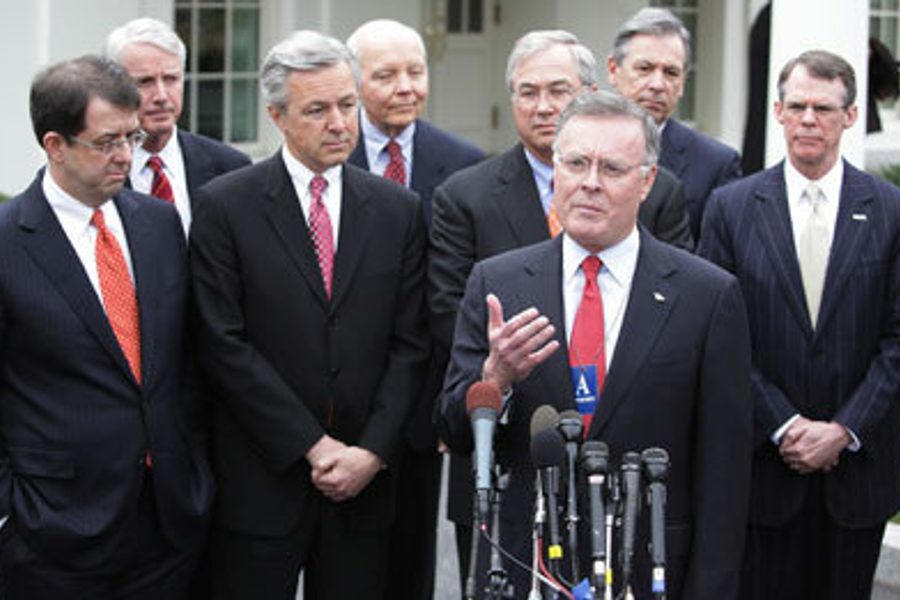
It’s hard to find a summary of the current economic crisis as precise and concise as the one offered by Carl Rosen, president of the United Electrical workers union’s western region:
“This economy is failing because workers cannot buy back what they are making. Corporations are being bailed out and workers are being sold out.”
Indeed, U.S. corporate leaders have thoroughly repudiated the time-tested strategy of Henry Ford, who shocked fellow tycoons by paying his workers a princely $5 per day so they could afford to buy what they produced.
Instead, thanks to decades of union-busting, threats of relocation, and the destruction of much of America’s manufacturing base, American workers’ real wages stand at 18 percent less in 2007 than they were in 1973, as Les Leopold points out in his fine new book, The Looting of America.
Up until the Wall Street crash, Corporate America was pretty much untroubled by the loss of real purchasing power by American working families. After all, there was still plenty of buying power around the globe: One-fifth of the United States was still prospering, foreign workers in Europe could afford to buy more stuff than their lower-paid US counterparts, elites from Mexico to China were sitting on mounds of cash, and the unlucky bottom 80 percent of Americans still had access to their credit cards to run up more debt.
So the fact that the richest 1/10 of 1 percent earned more annually than the bottom half of America didn’t seem to pose any problem to those at the top.
Nor did the accelerating loss of America’s productive base cause much lost sleep among CEOs. The development of high-profit financial instruments by Wall Street investment banks lured away capital from steady but unspectacular earnings in basic American industries. Then, as corporations like U.S. Steel rendered themselves uncompetitive by buying up Marathon Oil instead of reinvesting in aging infrastructure, the shift away from America’s productive base to finance gained new momentum.
The corollary to financialization was the outsourcing of family-supporting U.S. jobs to low-wage, high-repression nations, as expressed by Jack Welch, then CEO of GE: “Ideally, you’d have every plant you own on a barge.”
While profits from the financial sector accounted for less than 2 percent of domestic corporate profits in the mid-1950’s, they soared to 27.4 percent by 2008, according to Leopold. The financial sector produced $313 billion in profits in 2003, compared with just $119 billion for manufacturing, as economist William Tabb has noted.
Most incredibly, as Leopold documents, the ratio of manufacturing workers to financial-sector employees shifted from 7.7 to 1 in 1960 to a mere 1.6 factory worker to each financier in 2008. “The only thing that has kept the economy going since Reagan is one sort of artificial bubble or another, because Corporate America has been destroying real production,” observes the UE’s Carl Rosen, one of the masterminds behind last December’s Republic Windows and Doors factory occupation in Chicago.
So what lessons about humility and compassion has the ongoing economic crisis and deepening misery of millions of Americans taught the country’s bankers?
Exactly zero, it would appear.
With one hand, Wall Streeters are grasping every possible federal dollar through bailout legislation, Treasury, FDIC and other agencies, all the while trying fiercely to evade any pay restraints. An incredible $12.3 trillion has now been shelled out in various forms of federal assistance, according to Nomi Prins, the author of It Takes A Pillage and a former Goldman Sachs executive.
But with the other hand, Wall Street bankers are ferociously resisting the prospect of any new regulation of their financial manipulations or restrictions on bonuses and CEO pay.
As Heather Booth, director of the newly-formed group Americans for Financial Reform, recently told me: “As serious as it is on healthcare, the lobbying and campaign contributions are even bigger on this effort protecting the Wild West economy that has produced such an economic disaster for most citizens.”








